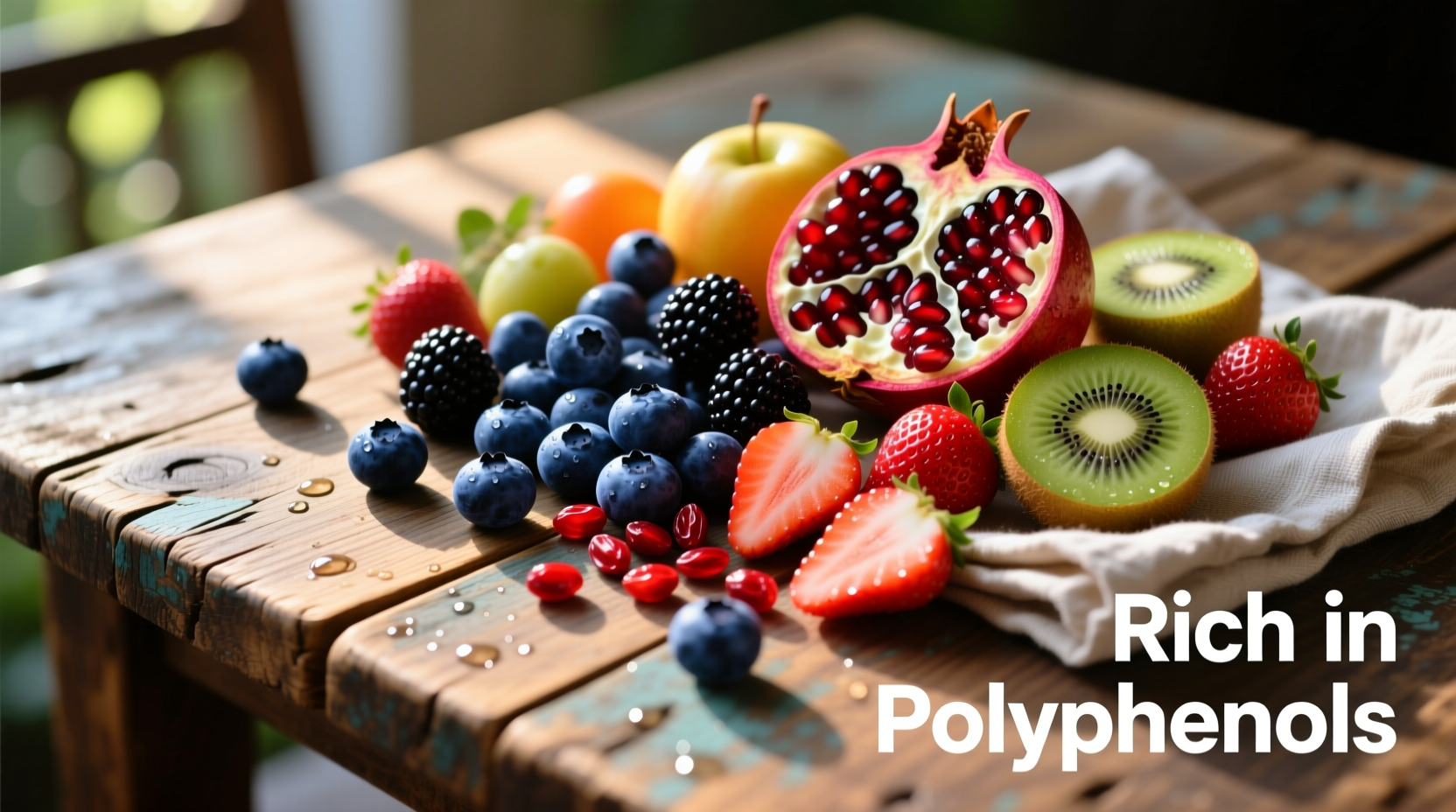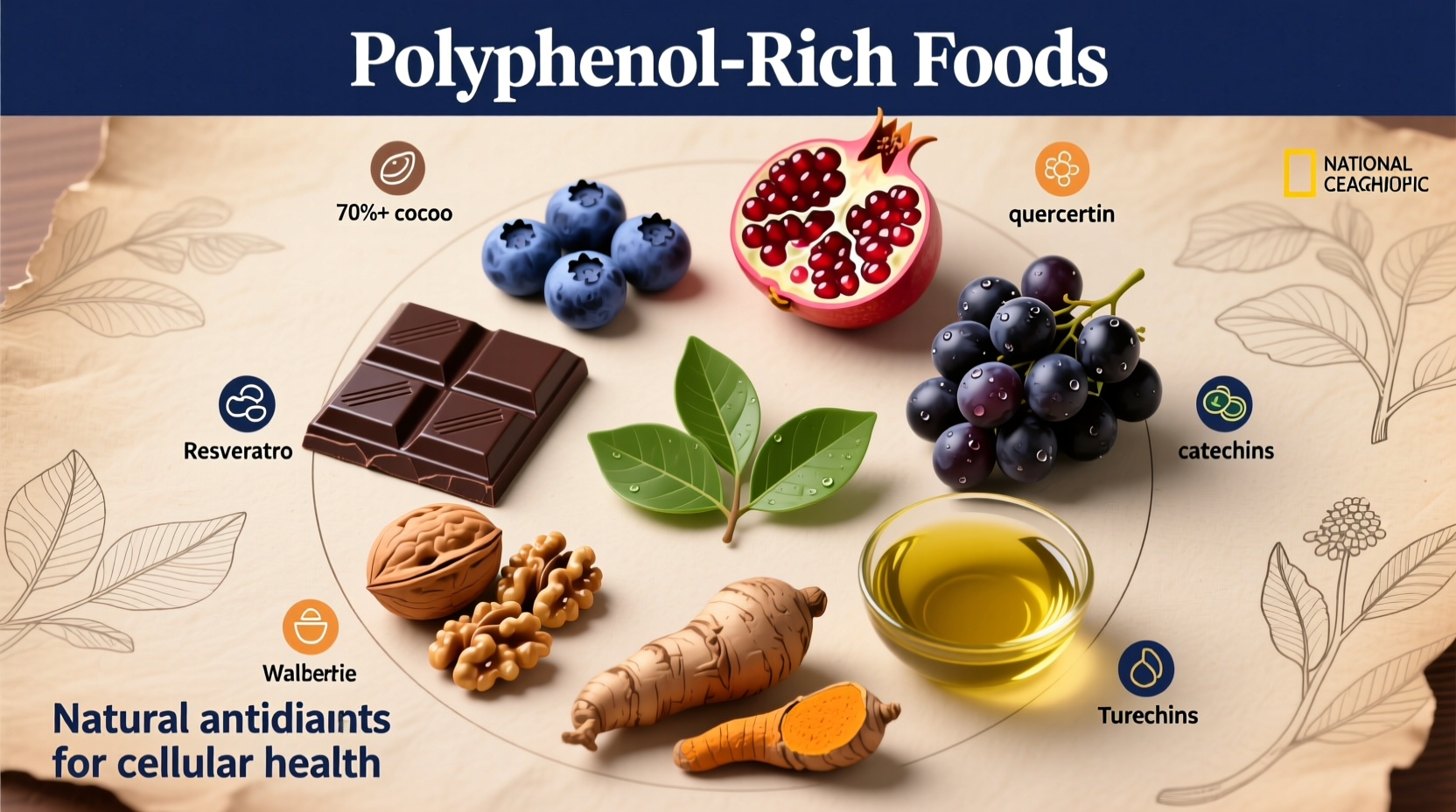Why Polyphenol-Rich Foods Belong on Your Plate Today
Discover how incorporating just three daily servings of polyphenol-packed foods can significantly enhance your antioxidant defenses. These naturally occurring compounds combat oxidative stress, support cardiovascular health, and may even protect against chronic diseases. Unlike supplements, whole food sources provide polyphenols in their most bioavailable forms, working synergistically with other nutrients for maximum benefit.
Top Polyphenol Food Categories at a Glance
Before diving into specifics, here's your quick-reference guide to the most potent polyphenol sources. This tiered system helps you prioritize foods based on both concentration and practical daily incorporation.
| Food Category | Polyphenol Concentration | Daily Serving Recommendation | Key Polyphenol Types |
|---|---|---|---|
| Dark Chocolate (70%+) | 500-1000mg per 100g | 1-2 small squares | Flavanols, Procyanidins |
| Berries (especially elderberries) | 300-500mg per cup | 1 cup fresh or frozen | Anthocyanins, Ellagic acid |
| Green Tea | 100-150mg per 8oz cup | 2-3 cups daily | Catechins (EGCG) |
| Extra Virgin Olive Oil | 100-300mg per tablespoon | 2 tablespoons daily | Oleuropein, Hydroxytyrosol |
| Nuts (especially pecans) | 50-100mg per ounce | Small handful daily | Ellagic acid, Flavonols |
Understanding Polyphenols: More Than Just Antioxidants
Polyphenols represent one of nature's most sophisticated defense systems. These compounds protect plants from environmental stressors, and when we consume them, they activate similar protective pathways in our bodies. Research from the National Institutes of Health reveals that polyphenols don't just neutralize free radicals—they actually enhance our body's own antioxidant enzyme production through a process called hormesis.
Fruit Powerhouses: Nature's Polyphenol Delivery System
Berries consistently rank as polyphenol superstars. A comprehensive analysis by the USDA's Agricultural Research Service found that elderberries contain approximately 1,300mg of polyphenols per 100g, while blueberries deliver around 330mg. But don't overlook everyday fruits—apples with skin provide about 130mg per medium fruit, primarily in the quercetin-rich peel.

Beverage Boosters: Sip Your Way to Better Health
Tea lovers rejoice—your daily habit delivers significant polyphenol benefits. Green tea's epigallocatechin gallate (EGCG) content ranges from 70-100mg per cup, while black tea provides theaflavins and thearubigins. Interestingly, research published in The American Journal of Clinical Nutrition shows that adding lemon to green tea can increase catechin absorption by up to 20%, while milk may decrease it.
Spices and Herbs: Concentrated Polyphenol Power
Did you know that cloves contain more polyphenols per gram than most fruits? With approximately 15,000mg per 100g, they're the undisputed champions. Other potent options include dried oregano (12,000mg), rosemary (9,000mg), and cinnamon (8,000mg). Incorporating just 1-2 teaspoons of these spices daily can significantly boost your polyphenol intake without altering your diet substantially.
Maximizing Polyphenol Benefits: Practical Implementation Guide
Simply adding polyphenol-rich foods isn't enough—you need to optimize absorption. Food matrix effects significantly impact bioavailability. Pairing healthy fats with polyphenol-rich foods enhances absorption of fat-soluble compounds. For example, drizzling olive oil on a spinach salad increases absorption of spinach's kaempferol. Conversely, avoid consuming high-fiber foods simultaneously with certain polyphenols, as fiber can bind to and reduce absorption of some compounds.
Research Timeline: The Evolution of Polyphenol Science
The scientific understanding of polyphenols has evolved dramatically:
- 1930s: First identification of flavonoids as plant pigments
- 1950s: Discovery of vitamin P activity (later identified as flavonoids)
- 1990s: Recognition of antioxidant properties and cardiovascular benefits
- 2000s: Identification of specific mechanisms including enzyme modulation
- 2010s-Present: Understanding of gut microbiome interactions and personalized responses
Context Matters: Factors Affecting Polyphenol Content
Your polyphenol intake varies significantly based on several factors:
- Growing conditions: Sun exposure increases polyphenol production in plants as a protective mechanism
- Ripeness: Many fruits reach peak polyphenol content just before full ripeness
- Processing: Cold-pressed extra virgin olive oil retains more polyphenols than refined oils
- Preparation: Light cooking can increase bioavailability of some polyphenols while destroying others
Building Your Daily Polyphenol Plan
Start your day with green tea and berries, incorporate spices liberally throughout meals, and finish with a square of dark chocolate. This simple approach delivers over 800mg of polyphenols daily—more than double the average Western diet. Remember that variety matters: different polyphenols target different biological pathways, so rotating through various sources provides comprehensive protection.
Frequently Asked Questions
How much polyphenols should I consume daily for health benefits?
While no official daily recommendation exists, research suggests consuming 500-1500mg daily provides significant health benefits. Most Western diets contain only 200-500mg, so increasing intake through whole foods is beneficial without risk of overconsumption from dietary sources.
Are polyphenol supplements as effective as whole food sources?
Whole food sources are generally superior to supplements. Research from the European Journal of Clinical Nutrition shows that isolated polyphenols often lack the synergistic effects created when consumed with other compounds naturally present in foods. The food matrix significantly impacts absorption and biological activity.
Does cooking destroy polyphenols in food?
The effect varies by compound and cooking method. Water-soluble polyphenols like anthocyanins can leach into cooking water, while fat-soluble compounds become more bioavailable when cooked with healthy fats. Steaming and quick stir-frying generally preserve more polyphenols than boiling. Some compounds like lycopene actually increase with cooking.
Can I get enough polyphenols on a limited budget?
Absolutely. Frozen berries often cost less than fresh but retain polyphenol content. Bulk spices, tea, and dark chocolate (70%+) offer excellent cost-per-polyphenol value. Focus on affordable powerhouses like black tea, apples with skin, and canned tomatoes (for lycopene) to maximize your budget while boosting polyphenol intake.











 浙公网安备
33010002000092号
浙公网安备
33010002000092号 浙B2-20120091-4
浙B2-20120091-4